Page 54 of 351
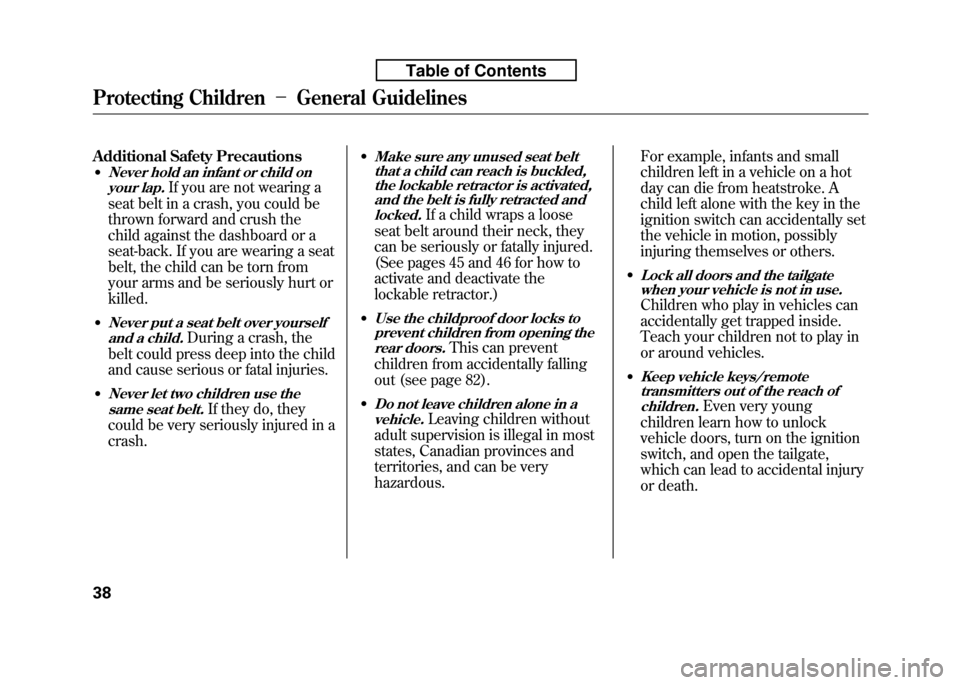
Additional Safety Precautions●
Never hold an infant or child on
your lap.
If you are not wearing a
seat belt in a crash, you could be
thrown forward and crush the
child against the dashboard or a
seat-back. If you are wearing a seat
belt, the child can be torn from
your arms and be seriously hurt orkilled.
●
Never put a seat belt over yourself and a child.
During a crash, the
belt could press deep into the child
and cause serious or fatal injuries.
●
Never let two children use the same seat belt.
If they do, they
could be very seriously injured in acrash. ●
Make sure any unused seat belt
that a child can reach is buckled,
the lockable retractor is activated,and the belt is fully retracted and
locked.
If a child wraps a loose
seat belt around their neck, they
can be seriously or fatally injured.
(See pages 45 and 46 for how to
activate and deactivate the
lockable retractor.)
●
Use the childproof door locks to prevent children from opening the
rear doors.
This can prevent
children from accidentally falling
out (see page 82).
●
Do not leave children alone in a vehicle.
Leaving children without
adult supervision is illegal in most
states, Canadian provinces and
territories, and can be veryhazardous. For example, infants and small
children left in a vehicle on a hot
day can die from heatstroke. A
child left alone with the key in the
ignition switch can accidentally set
the vehicle in motion, possibly
injuring themselves or others.
●
Lock all doors and the tailgate when your vehicle is not in use.
Children who play in vehicles can
accidentally get trapped inside.
Teach your children not to play in
or around vehicles.
●
Keep vehicle keys/remote transmitters out of the reach of
children.
Even very young
children learn how to unlock
vehicle doors, turn on the ignition
switch, and open the tailgate,
which can lead to accidental injury
or death.
Protecting Children -General Guidelines
38
Table of Contents
Page 55 of 351
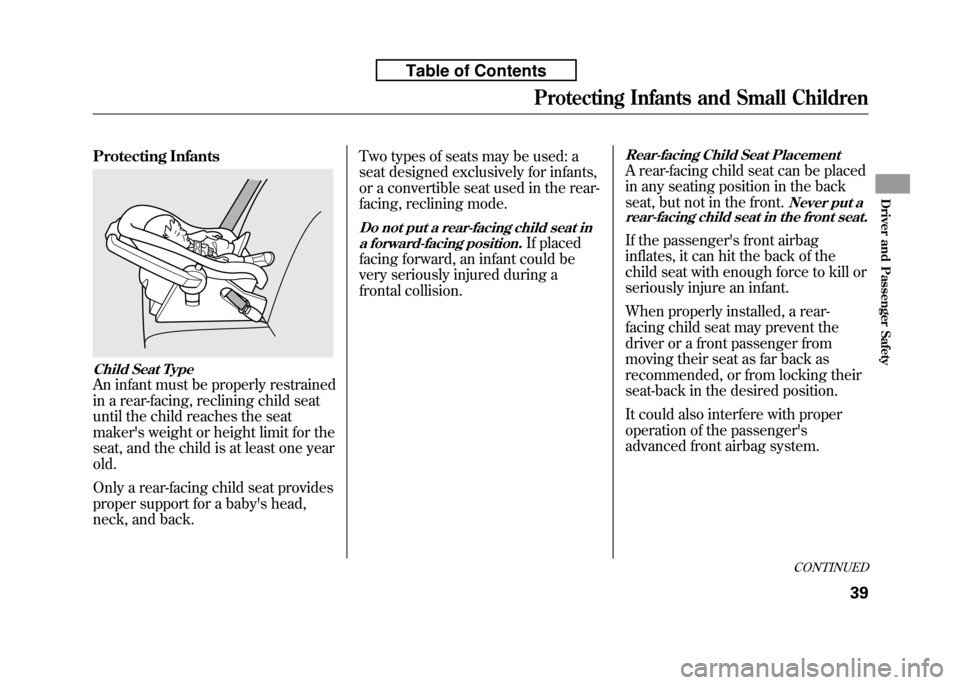
Protecting Infants
Child Seat Type
An infant must be properly restrained
in a rear-facing, reclining child seat
until the child reaches the seat
maker's weight or height limit for the
seat, and the child is at least one yearold.
Only a rear-facing child seat provides
proper support for a baby's head,
neck, and back.Two types of seats may be used: a
seat designed exclusively for infants,
or a convertible seat used in the rear-
facing, reclining mode.
Do not put a rear-facing child seat in
a forward-facing position.
If placed
facing forward, an infant could be
very seriously injured during a
frontal collision.
Rear-facing Child Seat Placement
A rear-facing child seat can be placed
in any seating position in the back
seat, but not in the front.
Never put a
rear-facing child seat in the front seat.
If the passenger's front airbag
inflates, it can hit the back of the
child seat with enough force to kill or
seriously injure an infant.
When properly installed, a rear-
facing child seat may prevent the
driver or a front passenger from
moving their seat as far back as
recommended, or from locking their
seat-back in the desired position.
It could also interfere with proper
operation of the passenger's
advanced front airbag system.
CONTINUED
Protecting Infants and Small Children
39
Driver and Passenger Safety
Table of Contents
Page 61 of 351
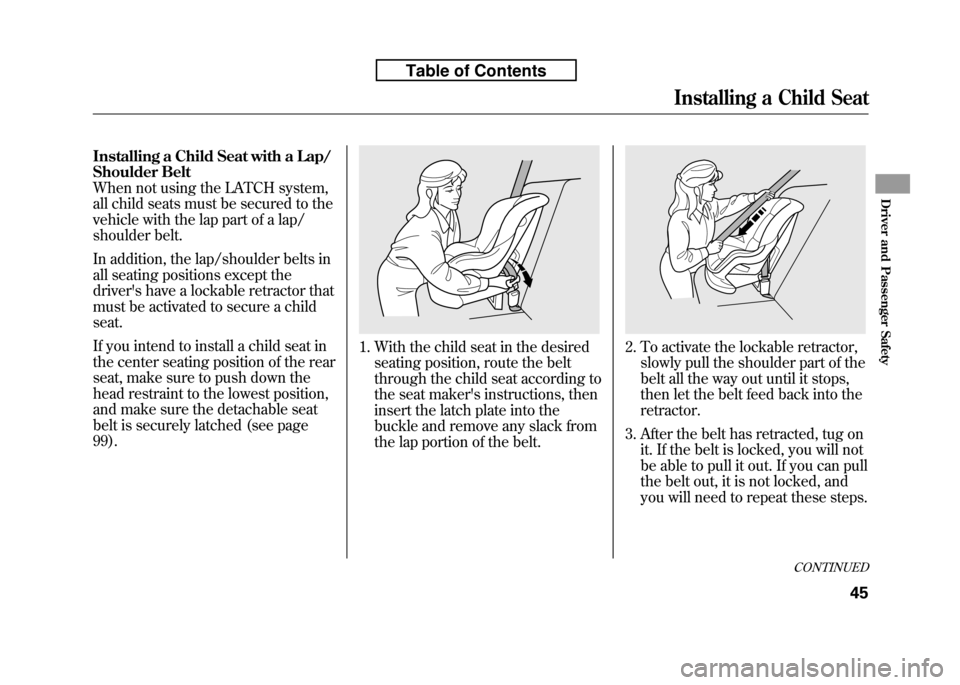
Installing a Child Seat with a Lap/
Shoulder Belt
When not using the LATCH system,
all child seats must be secured to the
vehicle with the lap part of a lap/
shoulder belt.
In addition, the lap/shoulder belts in
all seating positions except the
driver's have a lockable retractor that
must be activated to secure a childseat.
If you intend to install a child seat in
the center seating position of the rear
seat, make sure to push down the
head restraint to the lowest position,
and make sure the detachable seat
belt is securely latched (see page99).
1. With the child seat in the desiredseating position, route the belt
through the child seat according to
the seat maker's instructions, then
insert the latch plate into the
buckle and remove any slack from
the lap portion of the belt.2. To activate the lockable retractor,slowly pull the shoulder part of the
belt all the way out until it stops,
then let the belt feed back into theretractor.
3. After the belt has retracted, tug on it. If the belt is locked, you will not
be able to pull it out. If you can pull
the belt out, it is not locked, and
you will need to repeat these steps.
CONTINUED
Installing a Child Seat
45
Driver and Passenger Safety
Table of Contents
Page 62 of 351
4. After confirming that the belt islocked, grab the shoulder part of
the belt near the buckle, and pull
up to remove any slack from the
lap part of the belt. Remember, if
the lap part of the belt is not tight,
the child seat will not be secure.
To remove slack, it may help to put
weight on the child seat, or push
on the back of the seat while
pulling up on the belt.5. Push and pull the child seatforward and from side-to-side to
verify that it is secure enough to
stay upright during normal driving
maneuvers. If the child seat is not
secure, unlatch the belt, allow it to
retract fully, then repeat thesesteps. To deactivate the lockable retractor
and remove a child seat, unlatch the
buckle, unroute the seat belt, and let
the belt fully retract.
Installing a Child Seat
46
Table of Contents
Page 73 of 351
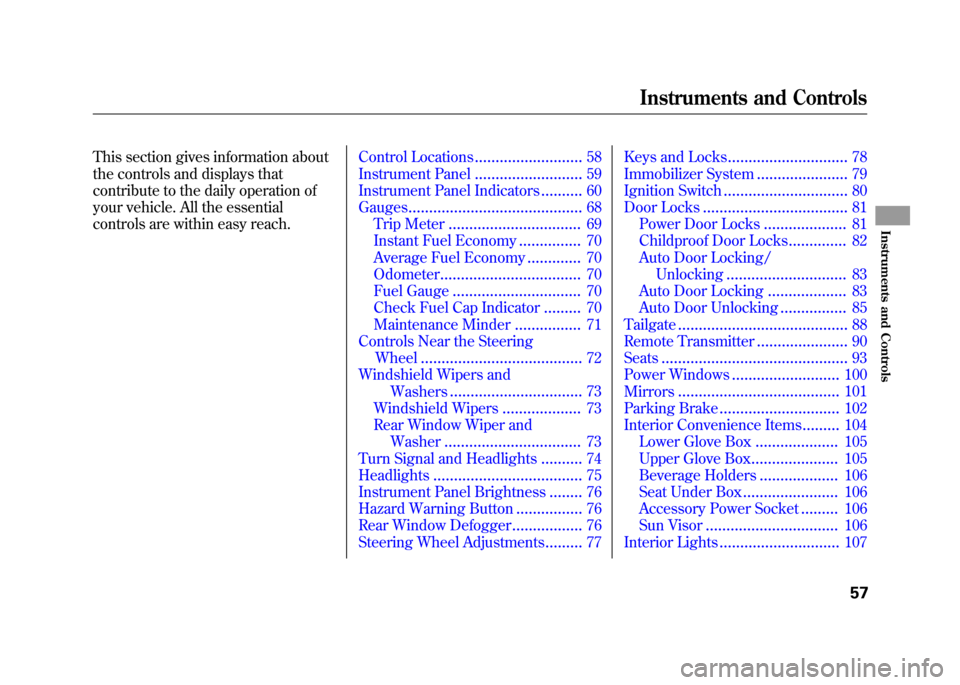
This section gives information about
the controls and displays that
contribute to the daily operation of
your vehicle. All the essential
controls are within easy reach.Control Locations..........................
58
Instrument Panel ..........................
59
Instrument Panel Indicators ..........
60
Gauges ..........................................
68
Trip Meter ................................
69
Instant Fuel Economy ...............
70
Average Fuel Economy .............
70
Odometer ..................................
70
Fuel Gauge ...............................
70
Check Fuel Cap Indicator .........
70
Maintenance Minder ................
71
Controls Near the Steering
Wheel .......................................
72
Windshield Wipers and Washers ................................
73
Windshield Wipers ...................
73
Rear Window Wiper and
Washer .................................
73
Turn Signal and Headlights ..........
74
Headlights ....................................
75
Instrument Panel Brightness ........
76
Hazard Warning Button ................
76
Rear Window Defogger .................
76
Steering Wheel Adjustments .........
77Keys and Locks
............................. 78
Immobilizer System ......................
79
Ignition Switch ..............................
80
Door Locks ...................................
81
Power Door Locks ....................
81
Childproof Door Locks ..............
82
Auto Door Locking/ Unlocking .............................
83
Auto Door Locking ...................
83
Auto Door Unlocking ................
85
Tailgate .........................................
88
Remote Transmitter ......................
90
Seats .............................................
93
Power Windows ..........................
100
Mirrors .......................................
101
Parking Brake .............................
102
Interior Convenience Items .........
104
Lower Glove Box ....................
105
Upper Glove Box .....................
105
Beverage Holders ...................
106
Seat Under Box .......................
106
Accessory Power Socket .........
106
Sun Visor ................................
106
Interior Lights .............................
107
Instruments and Controls
57
Instruments and Controls
Page 98 of 351
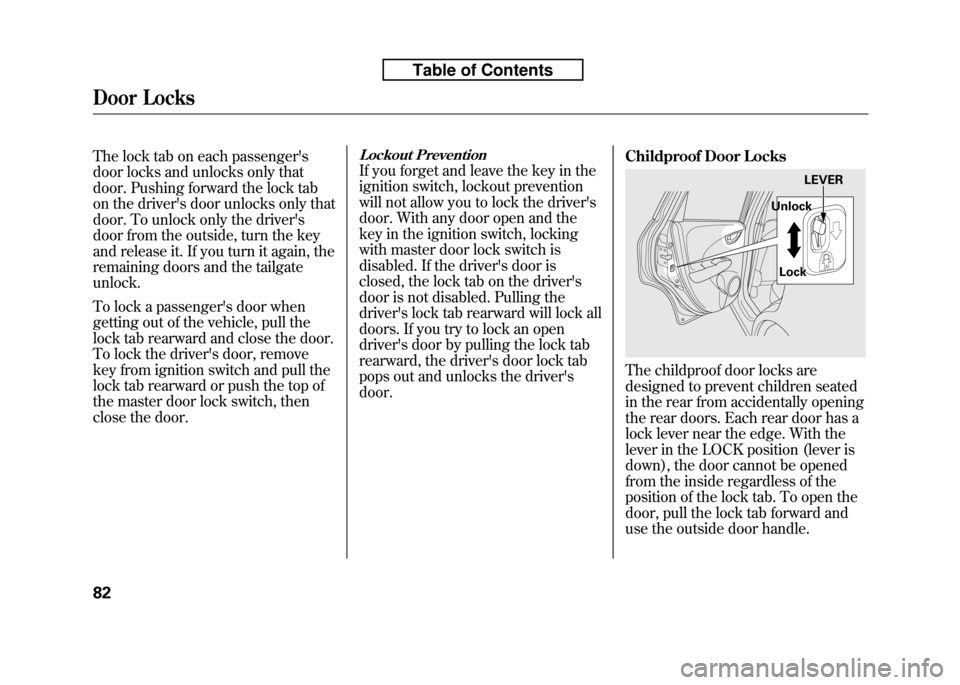
The lock tab on each passenger's
door locks and unlocks only that
door. Pushing forward the lock tab
on the driver's door unlocks only that
door. To unlock only the driver's
door from the outside, turn the key
and release it. If you turn it again, the
remaining doors and the tailgateunlock.
To lock a passenger's door when
getting out of the vehicle, pull the
lock tab rearward and close the door.
To lock the driver's door, remove
key from ignition switch and pull the
lock tab rearward or push the top of
the master door lock switch, then
close the door.Lockout Prevention
If you forget and leave the key in the
ignition switch, lockout prevention
will not allow you to lock the driver's
door. With any door open and the
key in the ignition switch, locking
with master door lock switch is
disabled. If the driver's door is
closed, the lock tab on the driver's
door is not disabled. Pulling the
driver's lock tab rearward will lock all
doors. If you try to lock an open
driver's door by pulling the lock tab
rearward, the driver's door lock tab
pops out and unlocks the driver'sdoor.Childproof Door Locks
The childproof door locks are
designed to prevent children seated
in the rear from accidentally opening
the rear doors. Each rear door has a
lock lever near the edge. With the
lever in the LOCK position (lever is
down), the door cannot be opened
from the inside regardless of the
position of the lock tab. To open the
door, pull the lock tab forward and
use the outside door handle.
LEVER
Unlock
Lock
Door Locks
82
Table of Contents